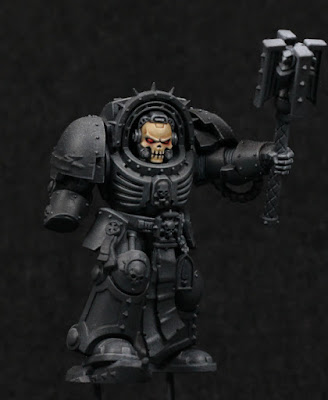 |
| I'd like this guy as a school chaplain. |
I wound up going with metallics for the chaplain, which so far seems to be working. The photo has them dulled down due to washes, but that will be fixed up later on. The main idea though is to be careful with the later highlighting and keep it consistent with non-metallic paint highlighting.
I'm using Balthasar Gold as the base here, just to keep it darker and in line with the gold method already used for the rest of Blood Angels that I've painted. There's also something else I've done: most of the details are gold, with very little variation in other colours. Sometimes I might paint a skull in bone colours, although for time saving practical reasons I've been doing less of that lately. I might try and paint a skull silver, but with a golden halo. None of that here: the trim and details are all the same. This isn't being lazy (although I certainly don't mind it being uncomplicated), but rather that I kind of felt it fit the model. Sometimes there's a certain elegance to simplicity. In the case of a Chaplain, I also feel that it lends an air of unyielding strength, the one in question devoted to their role and doesn't need flamboyance to show it. Sure that might be going overly analytical of a simple colour choice, but keeping in character to the model is what often informs how they're painted.
I don't have a photo of the shield, and was having a tough time deciding on the colours to use there. The background colour in particular I couldn't decide on, and then was playing with Blood Angels Red (Contrast) on a black background and thought it looked perfectly suitable. It was basically glazing the contrast paint on repeatedly until a transition from black to red started to appear. It's quite subtle, and I might need to edge some of it in Mephiston Red to bring it out a bit more, but thought it was a good experiment in yet another way to use Contrast paints. They're not normally applied over black.
The base I'm playing around with, but will probably go for something similar to the 30k assault marines in palette, with the idea that it can fit an industrial area or possibly the inside of a vessel. I don't have parts for "void war" bases or I'd use those: the armament suggests close combat in confined spaces (e.g a Space Hulk). I'll see how it goes.
Otherwise the model now feels to be well on the way, but there is one final note to make about it. With some details filled in, the black armour feels somehow "soft". That's only natural coming from the strong diffuse highlights; hardened black surfaces wouldn't have a reduced volume highlight profile, and be far more specular. I don't really want to fix this just yet, except perhaps on the feet, but at the end it might be a good idea to add very bright, defined edge highlights in places to darken the rest by comparison.
Definitely going with a white chapter symbol.
-- silly painter.


